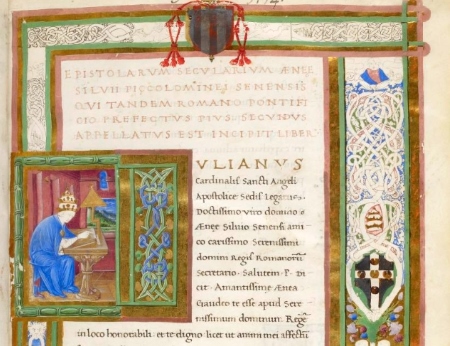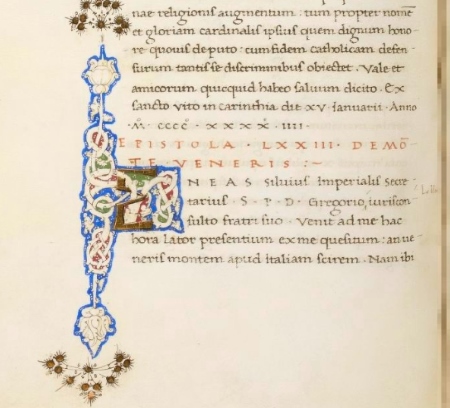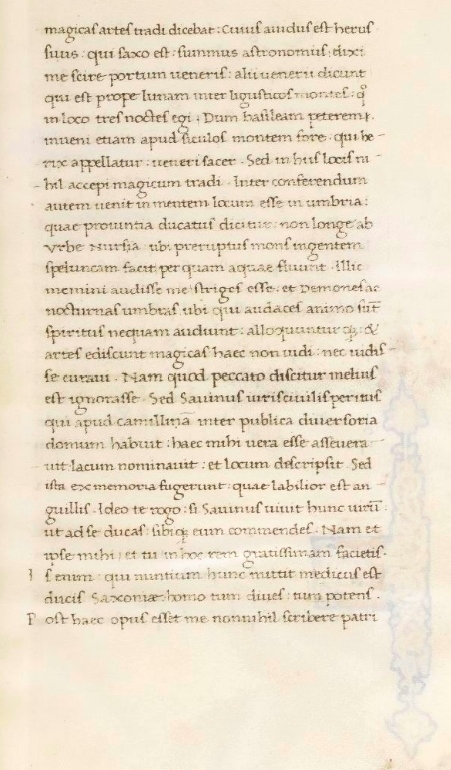8 Mar 2018
The Apennine Sibyl / Pope Pius II Piccolomini's original letter on the Sibyl's cave published for the first time ever (with new findings) /3
A cardinal, Silvio Enea Piccolomini, who in 1458 became Pope with the regnal name Pius II. A letter, which he wrote when he received a visit from a herald sent to him by an illustrious personage who was the physician and chief astronomer of a German duke. The gloomy fame of Mount Sibyl, in Italy, with a cave and a nearby lake, where many knew that necromacy was being practiced. An astounding piece of evidence that the Italian mountain was everything but an ordinary place: not just one of the innumerable peaks that made up the Apennine mountain ridge, which runs across the spine of Italy.
But when was Piccolomini's letter written, and where, and to whom was it addressed?
The scholars, who in recent years have considered Piccolomini's text in their studies on the legend and lore of the Apennine Sibyl, have made a number of mistakes.
At present, the common belief is that the letter was written by Silvio Enea in 1431, on his way to the Council of Basel, which was being held in that same year; and, according to this belief, the note was addressed to Piccolomini's brother, George.
All the previous bits of information are wrong.
This misconception was originated by the fact that all scholars had not the chance to access the original manuscripted version of the letter, which we are presenting in this article; instead, they all took into consideration the printed version published in Basel by Henrichum Petri in 1551 (see figure), which contains a number of omissions and inaccuracies.
Let's consider the year and place in which the letter was written down: the printed version does not contain any reference to such details; instead, the date and place are clearly set out in the final part of the original manuscripted version (see figure):
«[...] Do as if you were me: and what you wish, I will do accordingly. Be well, my dear. Written in Sankt Veit, Carinthia, on January, 15th 1444»
[In the original Latin text: «[...] Finge te esse me: et quid tunc velles, id facito. Vale optime. Ex sancto vito carinthia die XV ianuarii M.CCCC.XXXX.IIII»].
In 1444, Piccolomini was actually a secretary to Frederick III, the Duke of Styria, Carinthia and Carniola, in Austria, and King of the Romans, the title that preceded the formal coronation as Holy Roman Emperor. This fact is further confirmed by the heading of the letter, where Piccolomini declares to hold a post as «Imperialis Secretarius», a position he actually did not hold in year 1431.
The 1551 printed version contains another error as well: in the heading, it reads «to jurist George, his brother» («Georgio Iuriconsulto fratri suo», in Latin). But Enea Silvia had no such brother. For the manuscripted versions tells the reader a different story:
«... to jurist Gregory, his brother» («...Gregorio iuriconsulto fratri suo»).
The right name is not 'George', but 'Gregory', and the latter is Gregorio Lolli, a young cousin of Silvio Enea. Lolli was born in Siena and became a close friend of Silvio Enea Piccolomini when the future Pope was eightheen and decided to settle in the Tuscan town to attend the local University. The two friends shared the same love for the study of Latin authors and classical history. Lolli took his law degree in Siena in 1441, and he was still living there when Piccolomini wrote to him his letter about the 'Venusberg' in 1444. They used to write letters to each other, and owing to their friendship and mutual respect they often addressed each other as 'my brother'.
So what does this letter tell to us? From the text of the message, we know that in 1444 Silvio Enea Piccolomini entrusted the servant of an important personage, a prominent member of the court of the Duke of Saxony, to a close friend in Siena, for the arrangement of a meeting with an old jurist, Savinus, who had a specific knowledge on the dark fame which enshrouded a mountain and a lake lying in the vicinity of Norcia. Mount Sibyl and the Lake of Pilatus.
We are now left with the difficult task to unveil the identity of the unknown Saxon astronomer, the personal physician of a Duke of Saxony. Who was he?
We could not pinpoint his name, even though the available clues are of high significance.
We know that in 1444 Saxony, a territory in northern Germany ('Sachsen' in German), was split in two areas: the Saxe-Wittenberg, ruled by Frederick II The Gentle ('Friedrich der Sanftmütige'); and Saxe-Lauenburg, ruled by Bernhard II. But they were not the only existing Dukes of Saxony, as other relatives of theirs bore the same title (for instance, Wilhelm III, Frederick's younger brother).
Did they have a personal physician and astronomer? Of course they did, just like all other upper-rank ruling aristocrats of their historical age. We have lots of names of scholars, astronomers and physicians, who lived around that period in Germany and Austria: from Johann Schindel to Johannes Müller 'The Regiomontanus', from Bernhard Walther to Georg von Peuerbach, and many others. However, none seems to have been active in that exact years, of having been of Saxon origin, or having acted as personal physicians to any Saxon duke.
And the most promising name, that of Nicholas of Kues (Nicolaus Cusanus), the great German philosopher, diplomat, astronomer and physician, who was a close acquaintance of Silvio Enea Piccolomini and would have surely addressed his friend to retrieve information on a Venusberg in Italy, unfortunately seems to have nothing to do with Saxony and the dukes of Saxony.
So we have to leave to professional scholars, proficient in the history of ancient German Saxony, the impervious task of searching amid the antique papers for the identity of the Saxon Astronomer referred to by Piccolomini.
However, one fact is certain: in 1444 Mount Sibyl and its nearby lake were already notorious for being a place where necromancy was being performed. With no specific reference to any Sibyls.
This is a most important clue to a deeper understanding of the true nature of a magical mountain and lake that, in the fifteenth century, were being considered as very special places. Places worth a visit if you had a fancy for summoning demons.
Places that were possibly known for such peculiar use since much earlier times.
Sibilla Appenninica / La lettera originale di Papa Pio II Piccolomini sulla grotta della Sibilla pubblicata oggi per la prima volta (con nuove informazioni) /3
Un cardinale, Silvio Enea Piccolomini, che nel 1458 diventerà Papa con il nome di Pio II. Una lettera, che egli scriverà dopo avere ricevuto la visita di un messaggero a lui inviato da un illustre personaggio, astronomo e medico personale di un duca germanico. La fama tenebrosa del Monte Sibilla, in Italia, con la sua caverna e il vicino lago, presso i quali molti ritenevano che fosse praticata la negromanzia. Un'impressionante testimonianza in merito al fatto che quella montagna italiana rappresentava tutto fuorché un luogo ordinario: non si trattava affatto, semplicemente, di uno degli innumerevoli picchi che costellavano la catena dell'Appennino, lungo la spina dorsale dell'Italia.
Ma quando fu scritta quella lettera di Piccolomini, e dove, e a chi fu indirizzata?
Gli studiosi che, in anni recenti, si sono interessati al testo di Piccolomini nell'ambito dei propri studi sulla leggenda e sulle tradizioni relative alla Sibilla Appenninica, hanno commesso una serie di errori.
Attualmente, sussiste la convinzione che la lettera sia stata redatta da Silvio Enea nel 1431, nel corso del suo viaggio verso il Concilio di Basilea, che si sarebbe tenuto in quel medesimo anno, e che il messaggio sia stato indirizzato a Giorgio, suo fratello.
Ma tutti questi elementi risultano essere errati.
L'equivoco nasce dal fatto che i predetti studiosi non hanno avuto la possibilità di visionare il manoscritto originale della lettera, che noi stiamo invece presentando in questo articolo; essi poterono prendere in considerazione solamente la versione a stampa del messaggio, pubblicata a Basilea da Henrichum Petri nel 1551 (vedere figura), la quale contiene un certo numero di omissioni e imprecisioni.
Andiamo a considerare l'anno e il luogo in cui la lettera fu scritta: la versione a stampa non contiene alcun riferimento a tali dettagli; al contrario, la data e il luogo di redazione sono chiaramente indicati nella parte finale della versione originale manoscritta (vedere figura):
«[...] Fai pure come se tu fossi me: e ciò che tu desideri, io eseguirò. Stammi bene, mio caro. Scritto a San Vito di Carinzia nel giorno XV gennaio 1444».
[Nel testo originale latino: «[...] Finge te esse me: et quid tunc velles, id facito. Vale optime. Ex sancto vito carinthia die XV ianuarii M.CCCC.XXXX.IIII»].
Nel 1444, Piccolomini era infatti segretario di Federico III, Duca di Stiria, Carinzia e Carniola, in Austria, e Re dei Romani, titolo che precedeva la formale incoronazione a Imperatore del Sacro Romano Impero. Questo fatto è ulteriormente confermato dall'intestazione della lettera, nella quale Piccolomini dichiara di rivestire il ruolo di «Imperialis Secretarius», una posizione che egli non occupava affatto nel 1431.
La versione a stampa del 1551 contiene anche un ulteriore errore: nell'intestazione, si legge «a Giorgio giureconsulto, suo fratello» («Georgio Iuriconsulto fratri suo», in Latino). Ma Enea Silvio non aveva un tale fratello. In effetti, la versione manoscritta ci racconta una storia differente:
«a Gregorio giureconsulto, suo fratello» («...Gregorio iuriconsulto fratri suo»).
Il nome giusto non è 'Giorgio', ma 'Gregorio', e quest'ultimo è Gregorio Lolli, un giovane cugino di Silvio Enea. Lolli, originario di Siena, divenne intimo amico di Silvio Enea Piccolomini quando questi compì diciotto anni e decise di trasferirsi nella città toscana per frequentare la locale Università. I due amici condividevano la stessa passione per lo studio degli autori latini e per la storia classica. Lolli si laureò in legge nel 1441, e viveva ancora in Siena quando Piccolomini gli indirizzò quella lettera a proposito del 'Venusberg' nel 1444. Essi intrattenevano un frequente scambio epistolare, e proprio a causa dell'amicizia e del mutuo rispetto che li legava essi si apostrofavano, l'uno con l'altro, con l'epiteto di 'fratello'.
E dunque, cosa ci racconta, oggi, questa lettera? Da questo testo, veniamo a conoscenza del fatto che, nel 1444, Silvio Enea Piccolomini decise di affidare l'assistente di un importante personaggio, un membro eminente della corte del Duca di Sassonia, ad un proprio stretto conoscente di Siena, affinché fosse organizzato un incontro con un anziano giureconsulto, Savino, il quale disponeva di specifiche informazioni a proposito della fama oscura che avvolgeva una montagna e un lago che giacevano vicino alla città di Norcia. Il Monte Sibilla e il Lago di Pilato.
Ci rimane ora il difficile compito di svelare l'identità dello sconosciuto astronomo sassone, il medico personale del Duca di Sassonia. Chi era costui?
Non siamo stati purtroppo in grado di rintracciare il suo nome, benché gli indizi disponibili non siano certo insufficienti.
Sappiamo che nel 1444 la Sassonia, un territorio della Germania settentrionale ('Sachsen' in tedesco), era suddivisa in due aree: il Saxe-Wittenberg, governato da Federico II il Mansueto ('Friedrich, der Sanftmütige'); e il Saxe-Lauenburg, retto da Bernardo II. Ma non erano solo questi personaggi a potersi chiamare Duchi di Sassonia, in quanto altri parenti potevano fregiarsi del medesimo titolo (ad esempio, Wilhelm III, un fratello minore di Federico).
Chi di loro disponeva di un medico personale e di un astronomo? Praticamente tutti, come tutti gli aristocratici di elevata estrazione al governo in quegli anni. Conosciamo molti nomi di studiosi, astronomi e medici vissuti in quel periodo storico in Germania e in Austria: da Johann Schindel a Johannes Müller 'il Regiomontano', da Bernhard Walther a Georg von Peuerbach, e molti altri. Eppure, nessuno di questi sembra essere stato operativo esattamente in quegli anni, o essere stato di origine sassone, o avere operato in qualità di medico personale di un duca sassone.
E il nome maggiormente promettente, quella di Nicola Cusano (Nicolaus Cusanus), il grande filosofo, diplomatico, astronomo e medico tedesco, che fu una stretta conoscenza di Silvio Enea Piccolomini e che certamente si sarebbe rivolto al suo grande amico per ottenere informazioni su di un Venusberg italiano, sfortunatamente non sembra avere avuto nulla a che fare con la Sassonia o con i duchi sassoni.
E così, siamo costretti a lasciare agli studiosi professionisti, esperti nella storia dell'antica Sassonia germanica, l'arduo compito di ricercare, tra gli antichi documenti, l'identità dell'astronomo sassone al quale si riferiva il Piccolomini.
In ogni caso, un fatto risulta essere assolutamente indubitabile: nel 1444 il Monte Sibilla e il suo lago erano già un luogo famigerato, dove si diceva venisse praticata la negromanzia. Senza specifici riferimenti ad alcuna Sibilla.
Si tratta di un indizio di grande importanza per una più approfondita conoscenza della vera natura della magica montagna e del lago che, nel quindicesimo secolo, erano considerati quali luoghi estremamente speciali. Luoghi che valeva la pena di visitare, nel caso qualcuno fosse stato interessato all'evocazione di dèmoni.
Luoghi che erano forse già noti, per questo uso così peculiare, sin da tempi molto più antichi.
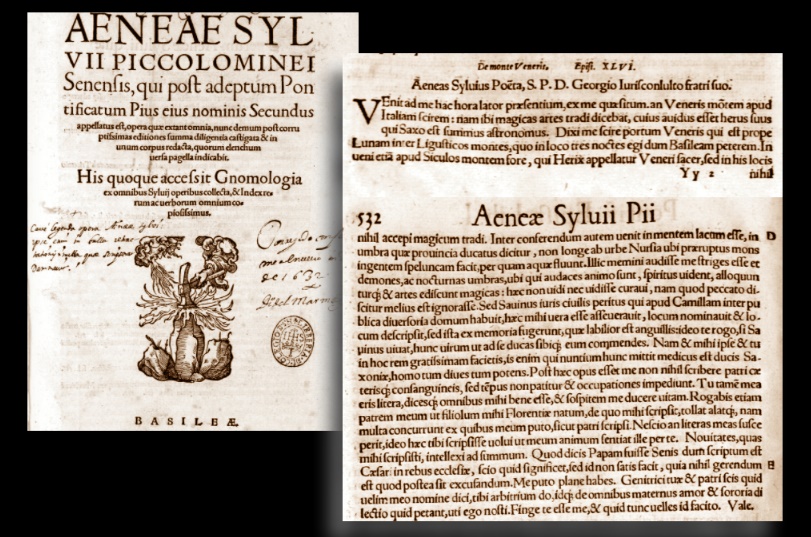

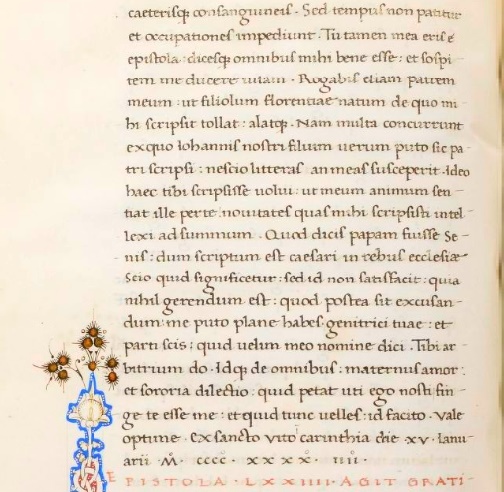

2 Mar 2018
The Apennine Sibyl / Pope Pius II Piccolomini's original letter on the Sibyl's cave published for the first time ever (with new findings) /2
When, in the first half of the fifteenth century, Silvio Enea Piccolomini, a prominent member of an illustrious Italian family from Tuscany, a cardinal of the Roman Church and a learned scholar, received a visit of a person who asked him for information on black magic, he became cautious to the greatest degree. In his position, this might have turned into an explosive matter, should the letter he was putting down fall into the wrong hands.
So, when we read his words today, we can sense all his circumspection in writing his letter to 'his brother' Gregory. He knows how to help his visitor, he knows about the gloomy fame of Mount Sibyl and the Lakes of Pilatus, the places where sorcery is practiced through the summoning of evil entities; yet he says he has a mere 'reminiscence' of it, he just 'once heard' about all that. And, for good measure, he adds the following words (see figure):
«I have never witnessed facts of that sort, nor have I ever cared to; since what is apprehended only through sin, it is much safer not to know at all».
[In the original Latin text: «haec non vidi, nec vidisse curavi. Nam quod peccato discitur melius est ignorasse»].
All that said, it is clear that cardinal Piccolomini does not want to simply dismiss his important visitor, the servant of an illustrious personage, sent to him by «a prominent Saxon astronomer» who is «craving for magic». He is so eager to please the scholar's assistant that he entrusts him to his correspondent, jurist Gregory, by sending the distinguished astronomer's servant from Carinthia, Austria to Siena in Italy (we will see later in this article for what reason Silvio Enea is in Austria, and the true personal details of Gregory), together with his own letter and a few stringent recommendations:
«In fact in this matter your kindness would be highly appreciated by myself too, because the man who sent this herald to me is the physician of the Duke of Saxony, a person as illustrious as powerful».
[In the original Latin text: «Nam et ipse mihi et tu in hoc rem gratissimam facietis, is enim qui nuntium hunc mittit medicus est ducis Saxoniae, homo tum dives tum potens»].
But why should the astronomer's and physician's assistant travel to Siena? Piccolomini intends to arrange a rendezvous between the astronomer's herald and another man from Siena, possibly an elderly scholar, who may possibly provide further information on the magical cavern and lake:
«Despite my scarce knowledge of the topic, Savinus, the man proficient in civil law who owns a house amid the public lodging houses in the district of the Porta Camollia [editor's note: a gate in the walls of Siena], he assured me that all such things are true, he once mentioned to me the name of the lake and also provided a description of the place; however, the whole matter has now long vanished from my memory, which is slicker than eels: so I kindly ask you, if Savinus is still alive, to take this man to his presence and entrust him to Savinus».
[In the original Latin text: «Sed Savinus iuris civilis peritus qui apud Camillinam inter publica diversoria domum habuit, haec mihi vera esse asseveravit, lacum nominavit et locum descripsit, sed ista ex memoria fugerunt, quae labilior est anguillis: ideo te rogo, si Savinus vivit, hunc virum ut ad se ducas sibique eum commendes»].
The future Pope, in his letter, openly professes his ignorance on the Italian mountain where black magic is practiced and claims he has no interest neither in knowing nor in remembering.
But let's think it over: would you ever tell an important person to travel from Austria to Italy and meet an elderly man just for the sake of a mere fairy tale? Would you really send a guy, who works for a distinguished scholar, a physician of a Duke, into a futile, unproductive journey? Would you play such a trick to the trustworthy servant of «a person as illustrious as powerful»?
Of course, no chance. Silvio Enea Piccolomini, at that time an Imperial secretary and a clever diplomat, knew perfectly well what he claimed he could but hardly remember, the information that seemed to be «slicker than eels» in his memory. He was more than certain that the tale about the cavern and lake was true. He believed in the story of Mount Sibyl.
On a mountain in the vicinity of Norcia, there were a cave and a lake where evil magic was employed. And that was no mere rumour. It was well worth a journey.
Piccolomini does not mention the noun “Sibyl”. Yet, it is clear that the place is the same described by Antoine de la Sale and Andrea da Barberino in their fifteenth-century works. And Silvio Enea stresses the point that, in that place, the main role is played by black magic. A primary, most important consideration, that we will expand in future articles.
But our research on Pius II's letter is not over yet. We still have to introduce a few additional remarks. Because many earlier scholars, who quoted from this letter with relation to the Apennine Sibyl, made a number of mistakes: first, Silvio's actual whereabouts when he wrote the letter; secondly, the letter's date; and, finally, the identity of Gregory, the 'brother' to whom the letter is addressed.
So we will provide all the correct information on Piccolomini's letter. In the next article.
Sibilla Appenninica / La lettera originale di Papa Pio II Piccolomini sulla grotta della Sibilla pubblicata oggi per la prima volta (con nuove informazioni) /2
Quando, nella prima metà del quindicesimo secolo, Silvio Enea Piccolomini, illustre esponente di una eminente famiglia italiana originaria della Toscana, cardinale di Santa Romana Chiesa, studioso ed erudito, fu oggetto della visita di una persona interessata alla magia e alle arti oscure, egli assunse un atteggiamento estremamente cauto. Nella sua posizione, la questione sarebbe potuta diventare esplosiva, nel caso la sua lettera fosse caduta nelle mani sbagliate.
Così, leggendo oggi le sue parole, possiamo percepire tutta la circospezione da lui utilizzata nel redigere la lettera indirizzata a 'suo fratello' Gregorio. Egli sa come potere aiutare il suo visitatore, conosce la tenebrosa fama del Monte Sibilla e del Lago di Pilato, luoghi presso i quali viene praticata la stregoneria, tramite l'evocazione di entità maligne; eppure, egli scrive di averne solo un labile ricordo, di averne solamente udito parlare. E, per buona misura, il futuro Papa non dimentica di aggiungere le seguenti parole (vedere figura):
«Queste cose io non le vidi mai, né mai mi curai di vederle. Perché ciò che si apprende a mezzo di peccato, è molto meglio ignorare del tutto».
[Nel testo originale latino: «haec non vidi, nec vidisse curavi. Nam quod peccato discitur melius est ignorasse»].
Detto ciò, è chiaro però come il cardinal Piccolomini non intenda semplicemente licenziare il suo importante visitatore, il servitore di un illustre personaggio, inviato presso di lui «da un eminente astronomo Sassone» che è «assetato» di arti magiche. Egli è così desideroso di compiacere l'assistente dello studioso da affidarlo nelle mani del proprio corrispondente, il giurista Gregorio, inviando il servitore dell'illustre astronomo dalla Carinzia, in Austria, fino a Siena in Italia (vedremo successivamente, in questo articolo, per quale ragione Silvio Enea si trovi in Carinzia e quale sia l'esatta identità di Gregorio), insieme con la lettera da lui stesso vergata e alcune pressanti raccomandazioni:
«Ora, in questa faccenda faresti anche a me cosa gratissima, perché la persona che mi ha inviato questo messaggero è il Duca di Sassonia, uomo tanto eminente quanto potente».
[Nel testo originale latino: «Nam et ipse mihi et tu in hoc rem gratissimam facietis, is enim qui nuntium hunc mittit medicus est ducis Saxoniae, homo tum dives tum potens»].
Ma perché l'assistente del medico e astronomo avrebbe dovuto intraprendere un viaggio fino a Siena? Piccolomini ha intenzione di organizzare un abboccamento tra l'inviato dell'astronomo e un altro personaggio senese, probabilmente un anziano erudito, il quale potrebbe essere in grado di fornire ulteriori informazioni sulla magica caverna e sul lago:
«Malgrado la mia scarsa conoscenza della materia, Savino, il grande conoscitore del diritto civile che possiede un'abitazione tra le pubbliche locande situate in prossimità di Porta Camollia [una delle porte della città di Siena n.d.r.], mi assicurò che tutte queste cose sono vere, mi fece menzione del lago e mi descrisse il luogo; tutto questo, però, mi è sfuggito dalla memoria, la quale è più scivolosa di un'anguilla; così ti prego, se Savino fosse ancora vivente, di condurre quest'uomo a lui, e di raccomandarglielo».
[Nel testo originale latino: «Sed Savinus iuris civilis peritus qui apud Camillinam inter publica diversoria domum habuit, haec mihi vera esse asseveravit, lacum nominavit et locum descripsit, sed ista ex memoria fugerunt, quae labilior est anguillis: ideo te rogo, si Savinus vivit, hunc virum ut ad se ducas sibique eum commendes»].
Il futuro Papa, nella sua lettera, professa apertamente la propria ignoranza in merito a quella montagna italiana presso la quale sarebbe praticata la magia nera e protesta di non avere interesse alcuno né a conoscere oltre, né a ricordare di più.
Ma pensiamoci bene: chi consiglierebbe mai, ad un uomo importante, di viaggiare dall'Austria all'Italia al mero scopo di incontrare un anziano signore, solo per la narrazione di una favoletta? Chi invierebbe mai una persona, che opera per conto di un illustre studioso, il medico personale di un Duca, verso un viaggio futile e improduttivo? Giochereste realmente un tale scherzo al servitore di un «uomo tanto eminente quanto potente»?
Ovviamente, tutto questo è impossibile. Silvio Enea Piccolomini, a quel tempo segretario imperiale ed esperto diplomatico, ben conosceva ciò di cui egli dichiarava di non ricordarsi affatto, ben rammentava quelle informazioni che sembravano essere, nella sua memoria, «più scivolose di un'anguilla». Egli era più che sicuro che tutto ciò fosse assolutamente vero. Egli credeva nella storia del Monte Sibilla.
Sulla cima di una montagna, vicino alla città di Norcia, esistevano una caverna e un lago dove veniva utilizzata la magia nera. E non si trattava di una semplice voce. Si trattava di qualcosa per la quale valeva la pena mettersi in viaggio.
Piccolomini non menziona mai la parola "Sibilla". È chiaro, comunque, come questo sia il medesimo luogo descritto anche da Antoine de la Sale e Andrea da Barberino nelle loro opere risalenti al quindicesimo secolo. E Silvio Enea pone l'accento sul fatto che, in quel luogo, il ruolo principale sia giocato dalla magia nera. Una considerazione fondamentale, di primaria importanza, che torneremo ad approfondire in futuri articoli.
Ma la nostra ricerca sulla lettera di Pio II non è ancora finita. Dobbiamo menzionare alcune ulteriori informazioni. Perché molti studiosi, che in precedenza hanno citato questa lettera in relazione alla Sibilla Appenninica, hanno compiuto in realtà un certo numero di errori: in primis, il luogo dal quale Silvio vergò la propria missiva; in secondo luogo, la data di redazione della lettera; e, infine, l'identità di Gregorio, il 'fratello' al quale la missiva è indirizzata.
Così, avremo modo di fornire tutte le corrette informazioni sulla lettera di Piccolomini. Nel prossimo articolo.
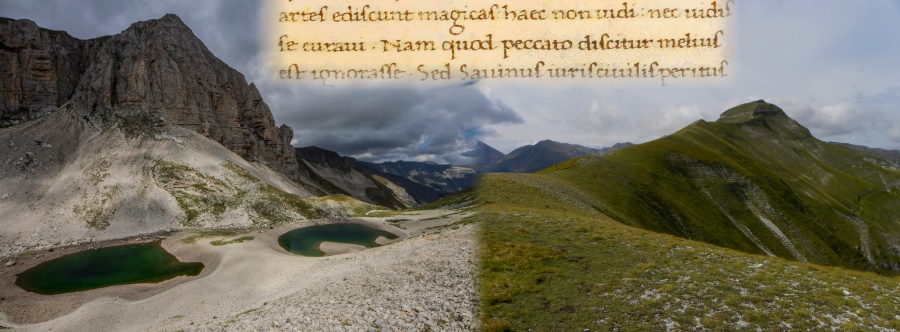

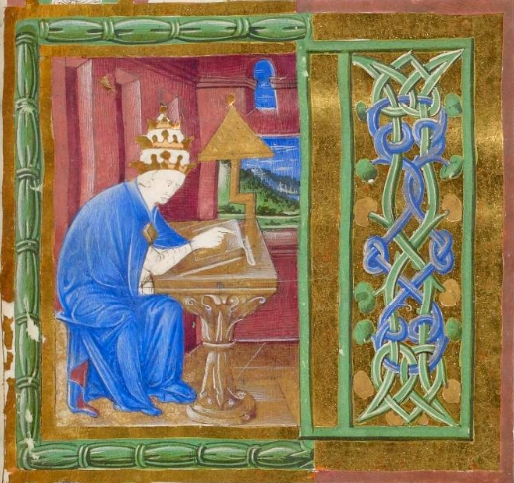

27 Feb 2018
The Apennine Sibyl / Pope Pius II Piccolomini's original letter on the Sibyl's cave published for the first time ever (with new findings) /1
It is with the greatest pleasure that “The Apennine Sibyl - A Mystery and a Legend” is proud to present to the research community and the general public the most famous letter written by a great Pope, Pius II Piccolomini, on the subject of Mount Sibyl in the first decades of the fifteenth century.
It is the first time ever that the letter is shown in his original manuscripted version, preserved at the Bibliothèque Nationale de France (Département des Manuscrits, Latin 8578). The fine script is by the hand of the Pope himself, Enea Silvio Piccolomini, a learned scholar, poet and writer, who decided to copy into a single manuscripted volume all the letters written during the period which preceded his election to Papacy. The volume also contains an elegant miniature showing the Pope as he sits at a scribe's desk of his time (see figure).
But the most interesting aspect is that Letter n. LXXIII in the manuscript contains the original version of the renowned text written by the then thirty-nine-year-old Piccolomini on the Apennine Sibyl. The letter was previoulsy known only from the printed version published in 1551 in Basel.
And we will see that a couple of new remarkable findings will unexpectedly pop up from the perusal of this original version, never published before.
The Apennine Sibyl. Her mountain and cave, in Italy. A mystery that, during the fifteenth century, was being brought to the attention of a wider audience by the literary works of Andrea da Barberino and Antoine de la Sale. An enigma that, according to Felix Hemmerlin, a cleric and essayist who lived in the same period, seemed to have a strong connection with the German legendary tale of Tannhäuser and the Venusberg, the mountain which housed the magical realm of Goddess Venus.
In the first half of the fifteenth century, when his Papacy wall still to come, Silvio Enea Piccolomini received a visit from a person who asked him very peculiar questions. And he decided to write to his beloved brother Gregory to ask for further information. The following is the text of the letter sent by Silvio Enea to his brother on the day of January, 15 1444.
The title of the letter leaves no space for doubts: it's «De Monte Veneris», a direct reference to the legend of Tannhäuser. And to the Italian Sibyl:
«Imperial Secretary Enea Silvio sends many greetings to jurist Gregory, his brother.
The bearer of this letter came to me in this very hour asking me a question: whether I know any Mount of Venus be in our land of Italy. In fact he said that knowledge is imparted there of magical arts, of which his master is eager to know, a prominent Saxon astronomer».
[In the original Latin text: «Aeneas Silvius Imperialis Secretarius S.P.D. (salutem plurimam dicit) Gregorio iuriconsulto fratri suo. venit ad me hac hora lator presentium ex me quesitum: an veneris montem apud italiam scirem. Nam ibi magicas artes tradi dicebat, cuius avidus esset herus suus qui Saxo est summus astronomus»].
So somebody, an assistant to an eminent German scholar of the time, was looking for information about a magical mountain that seemed to raise its peak in Italy and was known as the 'Venusberg', which was the very name of the mount that appears in the legend of Tannhäuser.
And here is the remarkable reply provided by Piccolomini. In the beginning, he is doubftul and perplexed:
«I replied to him that I knew a Harbour of Venus, also called of Venerius, which is near Luni amidst the mountains of Liguria, where I spent three nights when I was on my journey to Basel. Furthermore, I know a mount in Sicily named Erice, which is consecrated to Venus; however I have never heard that in those places magical arts are taught».
[In the original Latin text: «Dixi me scire portum Veneris. Alii venerii dicunt qui est prope lunam inter Ligusticos montes, quo in loco tres noctes egi dum Basileam peterem. Inveni etiam apud siculos montem fore, qui Herix appellatur, Veneri sacer. Sed in his locis nihil accepi magicum tradi»].
But then the learned Italian scholar is striken by a reminiscence:
«In discussing the subject, it came to my mind that there is a lake, in Umbria - which is known as the province of the Duchy - not far from the town of Norcia, where a craggy mountain opens into a huge cavern, through which the running waters flow. I remember I once heard that witches are found there and fiends and nocturnal wraiths; there those who house a bold heart can hear the voices of fiendish spirits, and talk to them and learn from them the magical arts».
[In the original Latin text: « Inter conferendum autem venit in mentem lacum esse in umbria, quae provincia ducatus dicitur, non longe ab Urbe Nursia ubi preruptus mons ingentem speluncam facit per quam aquae fluunt. Illic memini audisse me striges esse et demones ac nocturnas umbras, ubi qui audaces animo sunt, spiritus nequam audiunt, alloquunturque et artes ediscunt magicas»].
This letter provides an independent confirmation of the fact that in the fifteenth century the Lake of Pilatus and the Sibyl's Cave were known within a distiguished milieu of highly-educated scholars and men of letters. And the renown was not founded only on the presence of an oracular Sibyl: that was a place where black magic was being practiced, and the rumours about this peculiar feature were already running, at that time, throughout Europe.
This text is no new finding: Pio II's letter has been published more than once, and in modern times it was presented by Giuseppe Santarelli in his book “Legends of the Sibillini Mountain Range” (1974 - 1979).
However, Santarelli could not rely on the text contained in the manuscripted version: he could only quote from the version printed in 1551 in Basel. And this printed version contains a few errors.
So, by continuing our perusal of the original manuscript of Pope Pius II's letter, we will find a few fresh new findings, that only “The Apennine Sibyl - A Mystery and a Legend” is able to present to a wider audience with the next article.
Stay tuned!
Sibilla Appenninica / La lettera originale di Papa Pio II Piccolomini sulla grotta della Sibilla pubblicata oggi per la prima volta (con nuove informazioni) /1
È con grande piacere che il sito "Sibilla Appenninica - Il Mistero e la Leggenda" è orgoglioso di presentare alla comunità dei ricercatori e al grande pubblico la famosa lettera scritta nella prima metà del secolo quindicesimo da un granda Papa, Pio II Piccolomini, nella quale si parla del Monte Sibilla.
È infatti la prima volta che questa lettera viene mostrata nella sua versione originale manoscritta, conservata presso la Bibliothèque Nationale de France (Département des Manuscrits, Latin 8578). L'elegante calligrafia è di mano dello stesso Papa, Enea Silvio Piccolomini, erudito, poeta e scrittore, il quale aveva deciso all'epoca di copiare in un unico volume manoscritto tutto il proprio epistolario relativo al periodo precedente l'elezione al soglio pontificio. Il volume contiene anche un'elegante miniatura che mostra Papa Piccolomini seduto al banco da copista tipico del suo tempo (vedere figura).
Ma l'aspetto più interessante di tutto ciò è che la Lettera n. LXXIII presente nel manoscritto contiene la versione originale del celebre testo redatto dall'allora trentanovenne Piccolomini a proposito della Sibilla Appenninica. Fino ad oggi, questa lettera era nota solamente grazie alla versione a stampa pubblicata a Basilea nel 1551.
E vedremo che, dalla lettura di questa versione originale, mai pubblicata in precedenza, sarà possibile rilevare almeno un paio di nuove significative informazioni.
La Sibilla Appenninica. La sua montagna e la caverna sulla cima, in Italia. Un mistero che, proprio durante il secolo quindicesimo, veniva portato all'attenzione di un pubblico più vasto tramite le opere letterarie di Andrea da Barberino e Antoine de la Sale. Un enigma che, secondo Felix Hemmerlin, canonico e polemista zurighese, pareva presentare una stretta connessione con il leggendario racconto tedesco relativo a Tannhäuser e al Venusberg, la montagna che nascondeva al proprio interno il magico regno della Dea Venere.
Nella prima metà del quindicesimo secolo, quando il suo papato non ha ancora avuto inizio, Silvio Enea Piccolomini riceve la visita di una persona che pone al futuro pontefice domande molto particolari. E così egli decide di scrivere al proprio amato fratello Gregorio, allo scopo di reperire ulteriori informazioni. Quello che segue è il testo della lettera inviata da Silvio Enea a suo fratello il giorno 15 gennaio 1444.
Il titolo della lettera non lascia spazio a dubbi: è «De Monte Veneris», un riferimento diretto alla leggenda di Tannhäuser. E alla Sibilla italiana:
«Enea Silvio Segretario Imperiale invia i propri cari saluti a Gregorio giureconsulto, suo fratello. È venuto da me proprio ora il latore della presente il quale mi ha posto questa domanda: se io fossi a conoscenza dell'esistenza di un Monte di Venere in Italia. Infatti, afferma il mio visitatore che qui si possano apprendere le arti magiche, delle quali è assetato il suo signore, un eminente astronomo Sassone».
[Nel testo originale latino: «Aeneas Silvius Imperialis Secretarius S.P.D. (salutem plurimam dicit) Gregorio iuriconsulto fratri suo. venit ad me hac hora lator presentium ex me quesitum: an veneris montem apud italiam scirem. Nam ibi magicas artes tradi dicebat, cuius avidus esset herus suus qui Saxo est summus astronomus»].
Dunque qualcuno, assistente presso un illustre studioso tedesco di quel tempo, era in cerca di informazioni a proposito della magica montagna che pareva levarsi in Italia ed era conosciuta come 'Venusberg', il nome del monte che appare nella leggenda di Tannhäuser.
Ed ecco la notevole risposta fornita da Piccolomini. All'inizio, egli appare dubbioso e perplesso:
«Gli ho risposto che ero a conoscenza di un Porto di Venere, che qualcuno chiama Venerio, il quale si trova vicino a Luni, tra i monti della Liguria, dove io trascorsi tre notti mentre mi trovavo in viaggio per Basilea. So anche che esiste un monte, in Sicilia, che si chiama Erice, sacro a Venere. Ma non ho mai avuto contezza che in questi luoghi si insegni alcunché di magico».
[Nel testo originale latino: «Dixi me scire portum Veneris. Alii venerii dicunt qui est prope lunam inter Ligusticos montes, quo in loco tres noctes egi dum Basileam peterem. Inveni etiam apud siculos montem fore, qui Herix appellatur, Veneri sacer. Sed in his locis nihil accepi magicum tradi»].
Poi, però, il grande erudito italiano pare ricordare qualcosa:
«Mentre parlavamo, mi venne in mente che esiste un lago, in Umbria, detta anche provincia del Ducato, non lontano dalla città di Norcia, dove un'impervia montagna ospita una immane caverna, attraverso la quale scorrono le acque. Mi ricordo di aver sentito dire che lì si trovano streghe e demoni e ombre notturne, un luogo nel quale coloro che posseggono un animo audace possono ascoltare le voci degli spiriti malvagi, parlare con loro ed apprendere le arti magiche».
[Nel testo originale latino: « Inter conferendum autem venit in mentem lacum esse in umbria, quae provincia ducatus dicitur, non longe ab Urbe Nursia ubi preruptus mons ingentem speluncam facit per quam aquae fluunt. Illic memini audisse me striges esse et demones ac nocturnas umbras, ubi qui audaces animo sunt, spiritus nequam audiunt, alloquunturque et artes ediscunt magicas»].
Questa lettera fornisce una conferma indipendente del fatto che, nel quindicesimo secolo, il Lago di Pilato e la Grotta della Sibilla erano conosciute nel contesto di un raffinato ambiente composto da uomini di lettere e studiosi di grande erudizione. E questa fama non era fondata solamente sulla presenza di una Sibilla oracolare: si trattava di un luogo dove ad essere praticata era la magia nera, e la nomea di questa particolare caratteristica si stava diffondendo, a quel tempo, in tutta Europa.
Il testo qui presentato non costituisce affatto una novità: la lettera di Pio II è stata pubblicata più volte in passato, e in tempi più recenti era stata presentata da Giuseppe Santarelli nel volume "Le Leggende dei Monti Sibillini" (1974 - 1979).
Eppure, Santarelli non poté accedere alla lettera contenuta nel nostro manoscritto: egli fu in grado di riportare solamente il testo contenuto nella versione stampata nel 1551 a Basilea. E questa versione a stampa contiene alcuni errori.
E così, nel continuare la nostra analisi della versione originale manoscritta della lettera di Papa Pio II, potremo reperire alcuni nuovi elementi mai notati prima, che solo "Sibilla Appenninica - Il Mistero e la Leggenda" sarà in grado di proporre all'attenzione del pubblico con il prossimo articolo.
Restate in ascolto!
